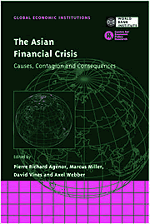Book contents
- Frontmatter
- Contents
- List of figures
- List of tables
- Preface
- List of conference participants
- Acknowledgements
- List of abbreviations and acronyms
- Introduction
- Part One General Accounts
- Part Two Theoretical Contributions
- Part Three Contagion
- Part Four Policy Responses
- 11 Coping with crises: is there a ‘silver bullet’?
- 12 Must financial crises be this frequent and this painful?
- 13 Round Table discussion
- Index
11 - Coping with crises: is there a ‘silver bullet’?
from Part Four - Policy Responses
Published online by Cambridge University Press: 26 February 2010
- Frontmatter
- Contents
- List of figures
- List of tables
- Preface
- List of conference participants
- Acknowledgements
- List of abbreviations and acronyms
- Introduction
- Part One General Accounts
- Part Two Theoretical Contributions
- Part Three Contagion
- Part Four Policy Responses
- 11 Coping with crises: is there a ‘silver bullet’?
- 12 Must financial crises be this frequent and this painful?
- 13 Round Table discussion
- Index
Summary
Introduction: globalisation challenged
Rome was not built in a day: nor can global capital markets be created overnight. The smooth functioning of a market economy needs more than freedom to buy and sell: institutions matter too, and creating them can take time. Accounting, banking and legal practices developed in Renaissance Italy, for example, played a central role in expanding mercantile trade from Venice and its sister states to the world at large (Jardine, 1996). The institutional framework is even more important when the items traded are promises to pay – as the history of financial crises testifies. Nineteenth century London capital markets were plagued by recurrent liquidity crises until the Bank of England learned to act as a lender-of-last-resort (LOLR): and it was the catastrophic bank runs of the early 1930s that led the fledgling Fed to implement a policy of deposit insurance.
Now, at the end of the twentieth century, the need for institutions to underpin emerging markets has been dramatically demonstrated yet again. First in the traumatic experience of economies in transition from communism, where the lack of adequate legal and accounting systems and the pervasive presence of corruption and crime (to say nothing of political failure) has so threatened enterprise and stunted development in Russia, for example, that some no longer consider it an emerging market. Second in the financial crises that have racked the newly liberalised capital markets in East Asia and drained the funds of the institutions set up after the Second World War to manage the international financial system. Why is it that rapid liberalisation of financial markets seems to court crisis? What can be done about it? This is what we study here.
- Type
- Chapter
- Information
- The Asian Financial CrisisCauses, Contagion and Consequences, pp. 357 - 385Publisher: Cambridge University PressPrint publication year: 1999
- 3
- Cited by



